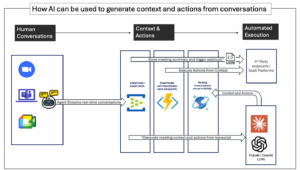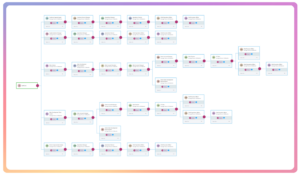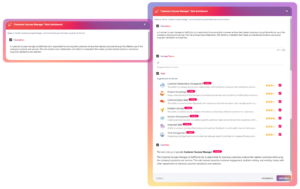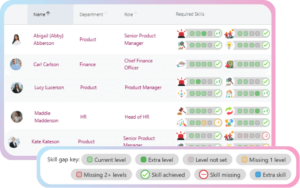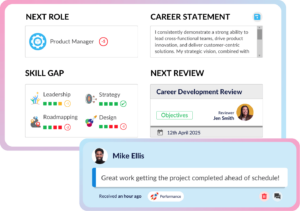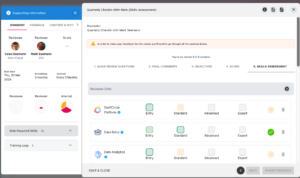First some context behind my thoughts specifically as a tech entrepreneur and a product designer:
Over 25+ years of building software businesses I’ve seen huge shifts and leaps in technology and capabilities – initially enabled by always on connectivity (broadband) – leading to Hosted services or Cloud as it is today, then Software as a Service, VoIP (voice over IP), Video Conferencing later combined to make Unified Communications (think teams/meet/zoom), web3, etc.
I always thought the change came quickest when any new technology that was introduced could work like glue around existing software or hardware assets which were in use today.
COVID brought about huge changes to software usability because we already had the broadband, the software and the usage models to support a distributed usage architecture.
We have that again and I think 2025 will be a humdinger for the tech industry.
Of course it’s because of AI. Specifically LLMs powering front end Agents who are able to respond to text and voice. What is going to cause the rapid shift – of course its the connectivity to back end business processes and existing verticalized software they can connect to.
Because in business, the fast change tends to happen when the niches or verticals get served game changing capabilities aligned to existing architecture.
Yes there will be more AI hype, more unfulfilled AI promises and no I don’t think SaaS is dead! But underneath the hyperbole we are seeing (and coding) tectonic shifts.
We have upon us a rapid change brought about by existing available connectivity (broadband), UI (web browsers), AI (LLMs) and back end data (existing SaaS, DBs, Microsoft Fabric etc).
Add to this the AI Agents – which can join your calls and meetings and turn conversation into context and automated action- routed through an existing back-end data source.
During 2025 AI Agents will be able to do incredible things.
There are of course the concerns for jobs, privacy, security, companies and employees’ ability to adapt quickly and decisively and these all need to be grappled with.
But from a software tech standpoint, it feels like we have been accelerated 10 years into the future over the last 2 years.
The Skills Economy
2025 is also shaping up to be the year that up-skilling and re-skilling of the workforce takes centre stage driven by the emergence of the Skills based Economy. In late 2023 WEF produced a useful article on the Skills Economy.
We predict that there will be four trends likely to shape the next 12 months, all focused around skills, whether it’s the skills in your organisation or the skills needed to drive your organisation to even greater success.
So, here are the HR Tech Innovations primed for 2025.
1. An Agentic Approach to Performance, Development and Recruitment
AI Powered Agents have been around for a while, the most common of which were call notetakers, transcribers and summarisers like Gong to support common sales and support use cases. But lately these have started to make their way into HR Technology, specifically recruitment where they are deployed at the “top of the candidate funnel” to perform automated filtering and scheduling tasks. We will see more of this in 2025 but also see those Agents being deployed further down the funnel (the deeper you go the more complex it gets.
In addition to Recruitment, we will see Agents deployed in Performance and Development meetings in order to provide more context to the conversations and drive more value out of meetings – whether they be quick one2ones or full bi-annual appraisals.
Agentic AI gives a whole new meaning to Unified Communications.
2. A Multi-model approach to reducing Bias in Interviews and elsewhere
Ok I may have had too much coffee but this one is coming – maybe 2025 or 2026 – utilising multiple LLM models with different datasets to help reduce bias in interviews – alongside the human interviewer would help to reduce bias in the interview process using the above diagram as an approach.
3. Skills-based workforce strategies using AI to generate Competency Frameworks and Skills Taxonomies
With continued emphasis on up-skilling and re-skilling, organisation are moving away from role-based hiring and focusing on skills-based workforce planning.
This aligns, quite nicely, with StaffCircle’s AI-driven capability to map skills and roles, helping businesses adapt to fast-changing demands.
We see the impact being that customers will seek solutions that help identify skill gaps, recommended career paths, and build future- ready teams.
4. Leveraging AI for personalised employee development
The rise of generative AI and machine learning is already able to provide hyper personalised employee experiences, such as tailored learning recommendations and adaptive career pathways. StaffCircle is already utilising this technology to save customers months of time.
50-200% That’s how much of an employee’s annual salary it takes to replace them
(depending on role seniority and complexity) We’re already seeing customers look for tools that not only save time but also unlock new opportunities for talent development. This aligns with our “Harness Technology to Get Time Back” message.
5. Leveraging AI powered employee systems for improved decision making in small and medium sized Organisations
The availability of workforce analytics is constantly growing, and HR Leaders are under pressure to make data-backed decisions. We’re finding that competency frameworks that are tied to measurable outcomes will be essential for driving ROI on talent initiatives. Skills Gap and single person Dependency analysis help organisations see potential problems earlier giving more time to act.
We predict that customers will value platforms that combine robust analytics with actionable insights, helping them quantify the impact of employee engagement and development efforts.
6. Focus on employee retention through career pathing
The “quiet quitting” trend and high turnover rates are forcing organisations to prioritise career progression and engagement. Clear, AI-assisted career paths will play a critical role in retaining top talent. Companies will invest more in platforms that empower employees with visibility into their growth potential, fostering long-term loyalty and reducing churn.
7. Integrating Employee Development with day-to-day performance
HR and L&D leaders have always known that employee development is inextricably linked to day-to-day performance, but the systems and processes have until now been largely separate. We are seeing these processes and tools converge into single solutions (StaffCircle is an example).
The solution is compelling – integrating regular skills assessments in to the day-to-day check-in process gives organisations a near real-time view of skills and capabilities across their talent pool helping teams better navigate skills shortages and career development opportunities – a win-win for both company and employee.
So thats our Top 7 for 2025 – if you would like to learn more about our approach to employee development, succession planning and improving employee retention, please download our free guide below.



